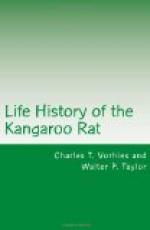The entire system for any one den seems to consist not only of the burrows within the mound itself, as described, but of those small outlying ones which we have referred to as subsidiary burrows. These are two to four in number, and are connected with the main mound by the runways already mentioned. They often seem to be way stations on the runways connecting main mounds, and there is seldom any mound of earth whatever in connection with them. One entire den system, the home mound and three subsidiaries, was mapped after being excavated (Fig. 3), all having been carefully gassed with carbon bisulphide. The subsidiaries were simple and contained no storage. Two of them were shallow, while in the third a depth of 48 centimeters was reached. They appear to be merely places of refuge, though the well-worn trails connecting them with the main mound indicate regular use. These runways are conspicuous on the Range Reserve, and are apparently characteristic of mounds throughout the range of the animal. Dwellers in different mounds must have rather extensive social contacts, notwithstanding the enmity of individuals toward each other in captivity. The main mound, in this instance very complicated, was in one place three stories high, and we have found as many as four utilized stories; but as a rule there are two or three only.
Since collapses are rather frequent during rainy seasons, aside from the trampling previously referred to, the kangaroo rats, where abundant, as on the Range Reserve, may well be a factor in increasing soil porosity and fertility; for in the course of time they probably have succeeded in plowing and cultivating the whole surface layer of the soil. They may thus be a factor in ecologic succession, tending to improve the character of the soil and adapt it to another stage.
Doubtless their own workings afford the only shelter the animals know. In the course of our digging in one mound, the occupant, an adult male, did not forsake the den until the excavation was three-fourths completed; and even then it did not leave by a burrow leading away from our operations, but came toward us, escaped the active efforts of four individuals bent on its capture, and ran speedily along a used runway toward another burrow several meters distant. A sack had been stuffed in the mouth of this, however, and, baffled, the rat then returned to the original burrow and was captured. Observations on other rats thus driven from the home mound indicate that they are very familiar with the runways of the vicinity of the mound and the various subsidiary burrows, and it is a question whether they need to see clearly to follow these runs. Apparently they never attempt to escape by forsaking their well-traveled runways. Tests of the maze-running ability of these animals by animal-behavior experts would be of extraordinary interest, in view of the character of the homes which they always inhabit and the network of runs on the outside.




